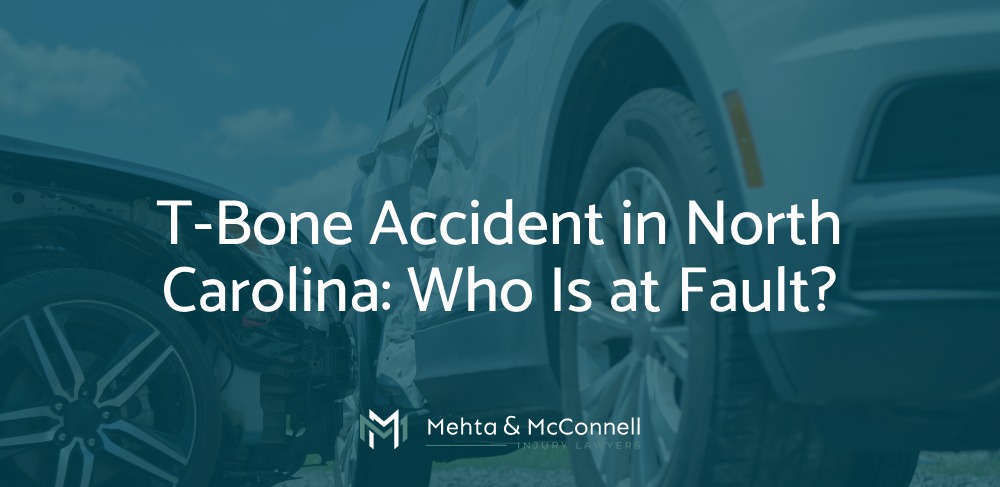
If you’ve been in a T-bone accident in North Carolina, you understand how terrifying and life-altering these collisions can be. As you navigate through the aftermath of such an incident, one pressing question looms large for a T-bone accident: Who’s at fault?
What Is a T-Bone Accident?
A T-bone accident occurs when one vehicle hits the side of another, usually at an intersection, forming a “T” shape. Red light running is a common cause.
These accidents are particularly dangerous due to the lack of structural protection on the sides of cars, making occupants more vulnerable to severe injuries, including spinal injuries, head trauma, and internal organ damage.
T-Bone Accident: Who’s at Fault?
In North Carolina, T-bone accident fault is determined based on the concept of negligence. Negligence is the failure to exercise reasonable care, resulting in harm to another party. Typically, the at-fault party will be the one who failed to act appropriately under the circumstances.
Whether it’s running a red light or failing to yield to an emergency vehicle, a negligence analysis will examine all of the circumstances of the accident in determining liability. Other factors may include mechanical issues or unfavorable road conditions, causing the vehicle to act in a way that could not be controlled.
Contributory Negligence
North Carolina follows a contributory negligence rule, which means if a court finds you to have contributed to the accident, even minimally, you may be barred from recovering damages. This strict rule makes establishing the other party’s fault in auto accidents essential.
Experienced Legal Counsel
Fault determination involves thoroughly investigating the circumstances leading to the collision, including witness statements, police reports, traffic laws, and driver behavior. Working with an experienced personal injury attorney can help ensure your rights are protected and help navigate the complexities of fault determination in such accidents.
What Are the Most Common Situations That Lead to T-Bone Accidents?
The specific circumstances of your accident will determine who was at fault. T-bone accidents often occur in the following situations:
Intersection Collisions
T-bone accidents often occur at intersections when one vehicle fails to yield the right of way. This can happen when a driver runs a red light, fails to stop at a stop sign, or turns improperly without yielding to oncoming traffic.
In most intersection accidents, the driver is usually at fault if they hit a pedestrian. By law, drivers must yield to pedestrians in crosswalks, and failing to do so typically makes them liable.
Left-Turn Accidents
A common T-bone scenario is when a vehicle turns left at an intersection and misjudges the timing, turning in front of oncoming traffic and causing a collision.
Failure to Yield
Drivers may fail to yield to other vehicles when merging into traffic, changing lanes, or entering a roadway from a driveway or parking lot, leading to a T-bone accident.
Speeding
Excessive speed reduces a driver’s ability to react to changing traffic conditions. Speeding drivers may not have enough time to stop or avoid a collision at intersections, increasing the risk of an accident.
Distracted Driving
Distractions such as texting, talking on the phone, adjusting the radio, or dealing with passengers can lead to a driver not noticing traffic signals, stop signs, or approaching vehicles.
Impaired Driving
Driving under the influence of alcohol or drugs impairs judgment, reaction time, and coordination, making drivers more likely to run red lights, fail to yield, or make unsafe turns that result in accidents.
Poor Weather Conditions
Rain, snow, ice, or fog can reduce visibility and road traction, making it harder for drivers to stop or maneuver safely at intersections, increasing the risk of a T-bone accident.
Mechanical Failures
Brake failures, tire blowouts, or other mechanical issues can cause drivers to lose control of their vehicles, leading to T-bone collisions with vehicles in their path.
Your Legal Rights and Seeking Compensation
If you’ve been injured in a T-bone accident in North Carolina, you have legal rights to seek compensation for your injuries, medical expenses, lost wages, pain and suffering, and other damages. To protect your rights and maximize your compensation, consider the following steps:
- Seek medical attention. Your health is the top priority. Seek medical care immediately, even if your injuries seem minor.
- Gather evidence. Collect evidence from the accident scene, including photos, witness contacts, and the other driver’s information.
- Report the accident. Report the accident to the police and obtain a copy of the police report.
- Contact an attorney. Consult with an experienced personal injury attorney who can evaluate your case, handle negotiations with insurance companies, and represent your interests in legal proceedings.
Understanding your rights under North Carolina’s personal injury law will help ensure you do not settle for less than you deserve.
Contact Mehta & McConnell Injury Lawyers
At Mehta & McConnell Injury Lawyers, we understand the complexities of T-bone accidents and the challenges you face in seeking fair compensation. Our compassionate and dedicated legal team is here to support you every step of the way.
If you’ve been injured in an accident and need legal assistance, don’t hesitate to reach out to us for a free consultation. Let us fight for the justice and compensation you deserve.

